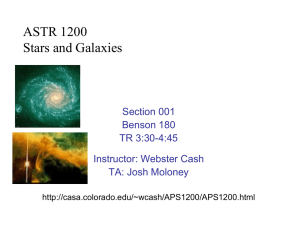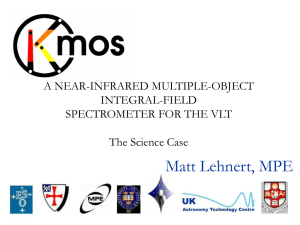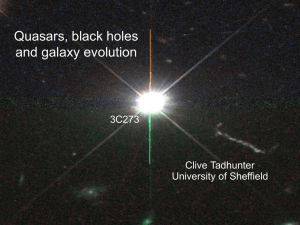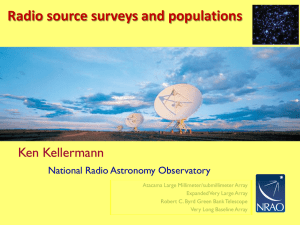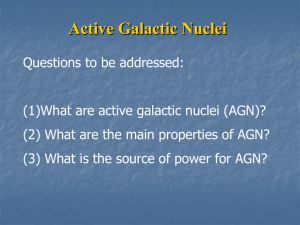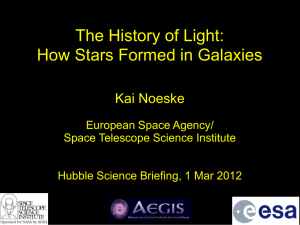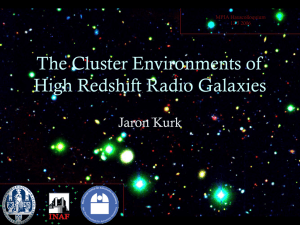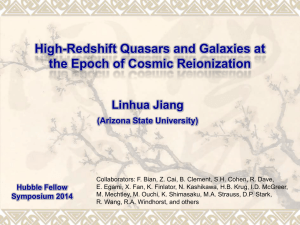class24
advertisement
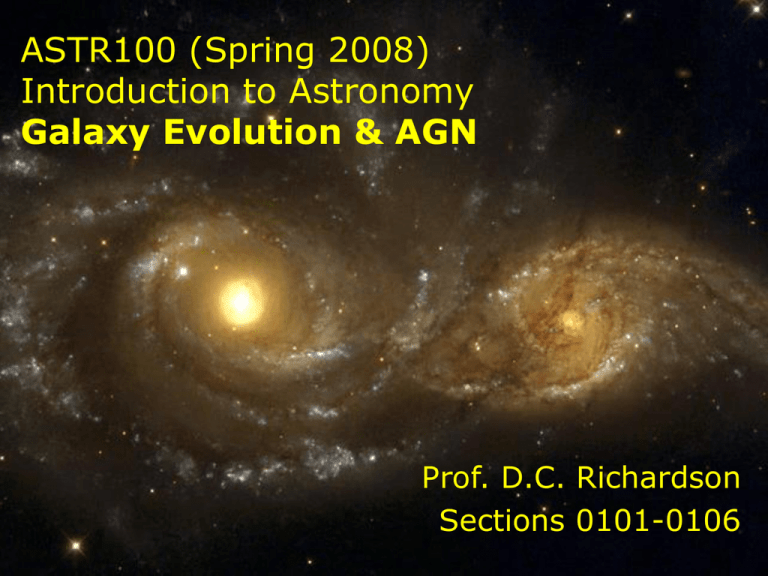
ASTR100 (Spring 2008) Introduction to Astronomy Galaxy Evolution & AGN Prof. D.C. Richardson Sections 0101-0106 How do we observe the life histories of galaxies? Deep observations show us very distant galaxies as they were much earlier in time. (Old light from young galaxies.) How did galaxies form? We still can’t directly observe the earliest galaxies. Our best models for galaxy formation assume: • Matter originally filled all of space almost uniformly. • Gravity of denser regions pulled in surrounding matter. Denser regions contracted, forming protogalactic clouds. H and He gases in these clouds formed the first stars. Supernova explosions from first stars kept much of the gas from forming stars. Leftover gas settled into spinning disk. Conservation of angular momentum NGC 4414 M87 But why do some galaxies end up looking so different? Why do galaxies differ? Why don’t all galaxies have similar disks? Conditions in Protogalactic Cloud? Spin: Initial angular momentum of protogalactic cloud could determine the size of the resulting disk. Different Types of Galaxy Formation Conditions in Protogalactic Cloud? Density: Elliptical galaxies could come from dense protogalactic clouds that were able to cool and form stars before gas settled into a disk. Different Types of Galaxy Formation Distant Red Ellipticals Observations of some distant red elliptical galaxies support the idea that most of their stars formed very early in the history of the universe. We must also consider the effects of collisions. Collisions were much more likely early in time, because galaxies were closer together. Many of the galaxies we see at great distances (and early times) indeed look violently disturbed. The collisions we observe nearby trigger bursts of star formation. Modeling such collisions on a computer shows that two spiral galaxies can merge to make an elliptical. QuickTime™ and a YUV420 codec decompressor are needed to see this picture. Collisions may explain why elliptical galaxies tend to be found where galaxies are closer together. Giant elliptical galaxies at the centers of clusters seem to have consumed a number of smaller galaxies. Starburst galaxies are forming stars so quickly that they will use up all their gas in less than a billion years. The intensity of supernova explosions in starburst galaxies can drive galactic winds. X-ray image The intensity of supernova explosions in starburst galaxies can drive galactic winds. Summary: Why do galaxies differ? Angular momentum may determine size of disk. Density of protogalactic cloud may determine how fast a galaxy forms. Collisions shape galaxies early on: Mergers of small objects make halo & bulge. Mergers of larger objects make elliptical galaxies. Relatively undisturbed (or late-forming) galaxies can still have disks. What are quasars? If the center of a galaxy is unusually bright we call it an active galactic nucleus. Quasars are the most luminous examples. Active Nucleus in M87 M87 Black Hole The highly redshifted spectra of quasars indicate large distances. From brightness and distance we find that luminosities of some quasars are >1012 LSun. Variability shows that all this energy comes from a region smaller than the solar system! Thought Question What can you conclude from the fact that quasars usually have very large redshifts? A. They are generally very distant. B. They were more common early in time. C. Galaxy collisions might turn them on. D. Nearby galaxies might hold dead quasars. Thought Question What can you conclude from the fact that quasars usually have very large redshifts? A. They are generally very distant. B. They were more common early in time. C. Galaxy collisions might turn them on. D.Nearby galaxies might hold dead quasars. All of the above! Galaxies around quasars sometimes appear disturbed by collisions. Quasars powerfully radiate energy over a very wide range of wavelengths, indicating that they contain matter with a wide range of temperatures. Radio galaxies contain active nuclei shooting out vast jets of plasma that emit radio waves coming from electrons moving at near light speed. The lobes of radio galaxies can extend over hundreds of thousands of light-years. An active galactic nucleus can shoot out blobs of plasma moving at nearly the speed of light. The speed of ejection suggests that a black hole is present. Radio galaxies don’t appear as quasars because dusty gas clouds block our view of the accretion disk. Characteristics of Active Galaxies Luminosity can be enormous (>1012 LSun). Luminosity can rapidly vary (comes from a space smaller than solar system). They emit energy over a wide range of wavelengths (contain matter with wide temperature range). Some drive jets of plasma at near light speed. What is the power source for quasars and other active galactic nuclei? Accretion of gas onto a supermassive black hole appears to be the only way to explain all quasar properties. Energy from a Black Hole Gravitational potential energy of matter falling into black hole turns into kinetic energy. Friction in accretion disk turns kinetic energy into thermal energy (heat). Heat produces thermal radiation (photons). This process can convert 10–40% of E = mc2 into radiation. Jets are thought to come from the twisting of a magnetic field in the inner part of the accretion disk. Do supermassive black holes really exist? Orbits of stars at center of Milky Way indicate a black hole with mass of 4 million MSun. Orbital speed and distance of gas orbiting center of M87 indicate a black hole with mass of 3 billion MSun. Black Holes in Galaxies Many nearby galaxies—perhaps all of them—have supermassive black holes at their centers. These black holes seem to be dormant active galactic nuclei. All galaxies may have passed through a quasar-like stage earlier in time. Galaxies and Black Holes The mass of a galaxy’s central black hole is closely related to the mass of its bulge. Galaxies and Black Holes The development of a central black hole must somehow be related to galaxy evolution.
